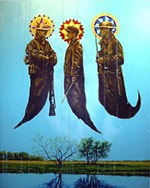‘Making It Together’
"Making It Together," the second part of the summer UT art grad shows at the CRL, gives quick answers to questions surrounding the idea of collaboration in art
Reviewed by Salvador Castillo, Fri., Aug. 25, 2006

"Making It Together"
Creative Research Lab, through Sept. 2
"Making It Together," the second part of the summer UT art grad shows at the CRL, presents different ways you can collaborate on an art project. There are the obvious two artists with work in close proximity (Roberto Bellini/David Woody or Erin Curtis/Stephanie Wagner), multiple artists adding their signature elements on a single work (Christa Mares/Scot Proctor or Sterling Allen/Anna Krachey), and artists inviting audience participation (Erin Cunningham or Jill Pangallo). This exhibit gives quick answers to questions surrounding the idea of collaboration in art.
Other circumstances operating in the art world are not touched upon in this show. Collectives are the first that come to mind. Collectives usually forego the celebrity status awarded to the individual artist by creating collaborations in a more democratic or communal process. Internet art also exploits the decentralization of power. And let's not forget the large-scale production of works by the likes of Christo or Robert Smithson. One could argue that this show was about the MFA candidates. But if Sterling Allen could be approached, why not Sodalitas?
That said, the works within the gallery walls are strong. Christa Mares and Scot Proctor create a whimsical installation with two opposing armies of ceramic bunny rabbits surrounded by a wide variety of objects and textures. It's like an old Nickelodeon or a late-night Cartoon Network cartoon with its over-the-top feeling. Looks like they just did what they pleased.
Karri Paul and Laura Turner explore space. Having Paul's landscape drawings hung next to Turner's photographs doesn't do much to investigate collaborations, but the gaping omissions of the graphite Italian countryside relate to the negative spaces and the unfamiliarity of the photographic images. Although some shots are interiors, they seem unrestrained. Without boundaries, it's all right to be free.
Practically hidden in the farthest corner, Jill Pangallo's performance/installation invites the viewer to participate in a number of exercises. At Natia's Corner you engage in New Age-type activities that can help overcome mental and spiritual obstacles. With just a few moments of your time, Natia could cure your disease.
At the entrance of the smaller space, two black TV sets face two black-and-white portraits. David Woody has a guy sitting studio-portrait-style, except the lighting isn't as generic, and the guy seems to have been in a recent fight. Roberto Bellini's televisions appear to be off until flashes reveal both sound and imagery. It is difficult to relate the two works. Yet the flashing might suggest a camera, the impact of punches, or the instant recall of memories. With all the bruises the guy had, he wasn't so good-looking, and the video was so hard to see.
Jarrod Beck's installation practically pulls you into the gallery. Hanging near the entrance, aluminum beams extend into the corner and drop down to create a wall. Ali Fitzgerald's pipe painting and accompanying mass of paintings hide in the dark. Beck's construction not only interrupts the gallery space, but it somehow unifies it, as well. The beams attract attention to all the divisions of space, and they connect the show as a single collaboration. He seems to be saying, "Come together, right now. Over me."










